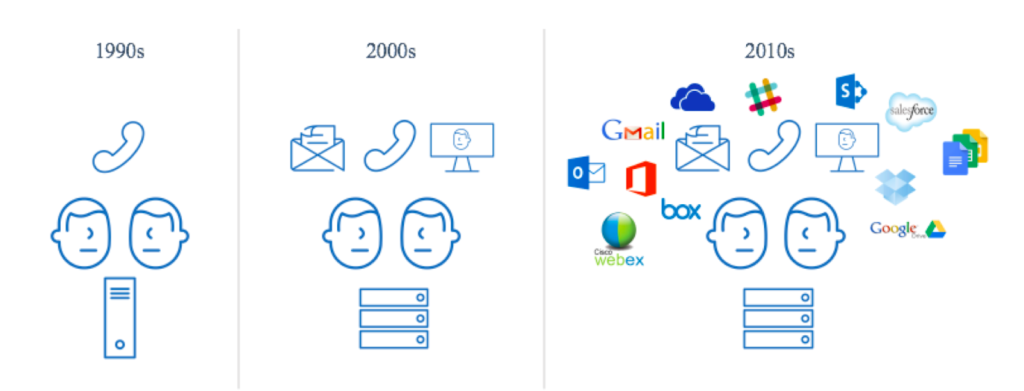From HR to the C-suite, people at every level of today’s organizations are discussing the digital workplace: what it is, how it impacts the employee experience, and perhaps more importantly, how to create a successful one. But defining “digital workplace” isn’t as easy as it sounds.
What is a digital workplace?
Deloitte calls it “the natural evolution of the workplace” – not exactly the most descriptive definition. CMSWire says it’s the “virtual equivalent to the physical workplace” – not much better. Even the Digital Workplace Group itself offers up eight definitions of digital workplace and encourages readers to choose their favorite.
Our favorite definition in the wild comes from CIO.com: The digital workplace is “a business strategy aimed at boosting employee engagement and agility through consumerization of the work environment.” They go on to explain that “Your digital workplace should help individuals and teams work more productively without compromising operations… [and] bring that same simplicity and intuitiveness to employees when they’re doing their mission-critical work.”
Employee engagement. Agility. Productivity. Intuitiveness. These are ideas after our own hearts here at Jive. However, we often speak of the digital workplace in even simpler terms. To us, at its core, the digital workplace is an ecosystem of people and knowledge.
The growth of the digital workplace
The digital workplace, like most things digital, began in the 1990s. Work was still largely tied to a physical location, but began to more strongly rely on technology. Imagine four people, sitting in a conference room, perhaps on the phone, typing and saving the meeting minutes onto a local computer that lived at the office (and still printing out paper copies).
The 2000s saw a more dramatic shift. Now work included email, chat, text messages, and remote servers. Connected by technology, employees started working from home. The workplace shifted from centralized and physical to dispersed and remote relatively quickly.

These days, we’re firmly in the middle of the digital revolution. There is an app for everything, dozens of communication channels, all of it in the cloud. The average enterprise ecosystem includes 329 apps, with employees context-shifting between apps every 2-3 minutes. Each of these apps is designed to improve the productivity of a single task, and often, they succeed. The challenge arises, however, when the entire ecosystem attempts to work together.
Without a solid strategy behind your digital workplace, it’s easy to fall into application overload. It becomes increasingly difficult to find people and knowledge and the employee experience suffers. Employees ask things like:
- What if I need to find an expert? I can’t just walk into the office and ask.
- How can I manage all these communication channels? Slack, Skype, email, phone, text… it’s impossible to keep track of it all.
- How do I know where to look for information – and when I find it, how can I easily get back to it without digging through all the apps again?
- What happens when my co-workers leave? It feels like all their knowledge walks out the door with them.
These digital workplace challenges won’t go away on their own. And the impact is significant. McKinsey and IDC estimate that almost 50% of the average knowledge worker’s time is spent searching for information and managing communications. A recent survey found that corporate memory loss – the loss of accumulated corporate knowledge – costs companies an estimated $430,000 per departing employee on top of the “usual recruitment replacement costs.”
To combat these issues, organizations need a digital workplace powered by a people and knowledge hub: the center of the ecosystem that acts as a corporate brain across multiple endpoints. Interactions and relationships within the ecosystem will drive the identification of knowledge needed by the user, which will become available proactively. However the organization evolves, whatever hot new apps comes in, it still works because you have one gateway to power collaboration.
3 must-haves for a successful digital workplace
So how do you get there? The right tool, for starters, but of course that can be different for different organizations. Whatever technology you choose, your digital workplace strategy should be built on three core pillars.
- Cloud. Your digital workplace must be powered by a cloud-based solution. Cloud-based technology is faster, more scalable, more efficient, and typically more cost effective. Innovation happens in the cloud, and the digital workplace must be a constantly evolving, innovative space.
- Mobile. There is no digital workplace without mobility. But that doesn’t just mean a smartphone app; your digital workplace solution should connect your employees easily and effectively no matter where they are. It should create a seamless employee experience across all channels with zero friction between and among them.
- Data. The digital workplace is powered by data. From the emerging capabilities of artificial intelligence (AI) and machine learning to semantic search and beyond, your digital workplace hub should use data from the entire ecosystem to help people work smarter, faster, and more productively, and ultimately, transform employee engagement.
This is the heart and soul of what we do at Jive, and we’re passionate about leading the way to a better digital workplace. Learn more about how Jive empowers the digital workplace.
GET A PERSONALIZED DEMO
See how Jive works. Request a personalized demo.
See for yourself how Jive can drive productivity and engagement across your organization. Get a free personalized demo.